Invasive Plant Species
What Is An Invasive Species?
Rhode Island Natural History Survey describes an invasive species as a species of plant, animal, or microbe that is:
- Introduced to a country or region where it is not native.
- Is reproducing and spreading without human cultivation.
- Is causing harm to native species or the areas in which they live.
Invasive species have a competitive advantage that allows them to grow and spread more aggressively than native species:
- In the absence of their natural predators or usual competing species, invasive plants make themselves at home quickly and can be very difficult to control.
- They can greatly harm our natural areas by outcompeting many native species so that only the invader is left.
- Invasive species can harm the breeding and nesting activities of animals, reduce food sources for native predators and pollinators, and disrupt natural water flow and filtration.
Learning to identify invasive plants and removing them not only helps to keep Green Infrastructure working (to keep our local waters clean) but also safeguards our natural areas, fish, and wildlife.
For more information and resources about invasive species in Rhode Island visit: https://rinhs.org/species/invasive-species/
Invasive Plants Outcompete Native Plants
The invasive Phragmites australis (also known as common reed) has taken over wetlands across Rhode Island and the eastern seaboard. Common reed blocks native salt marsh vegetation, eliminates natural refuge and feeding areas for local species, and even alters the hydrologic function of wetland areas.

Invasive Plants Can Harm Valuable Species
Monarch butterflies rely on native milkweed plants as their major food source and a place to lay their eggs. However female monarchs often confuse milkweed with its non-native look-alike black swallow-wort. Larvae that hatch on swallow-wort cannot mature due to a toxin produced by the plant. Swallow-wort infestations that go unchecked jeopardize the success of the monarch butterfly population. This is just one example of how invasive plants can harm valuable pollinator species
